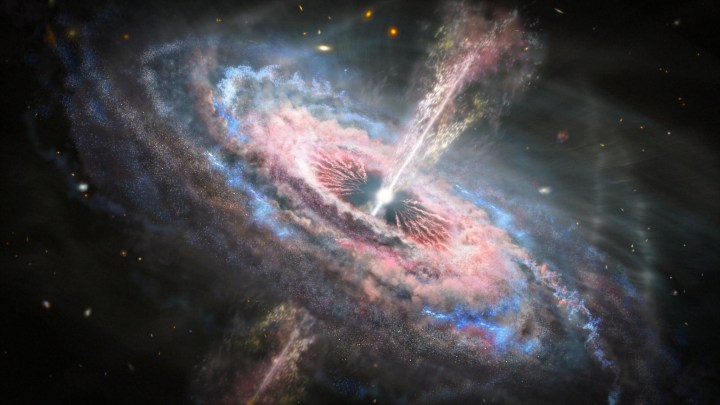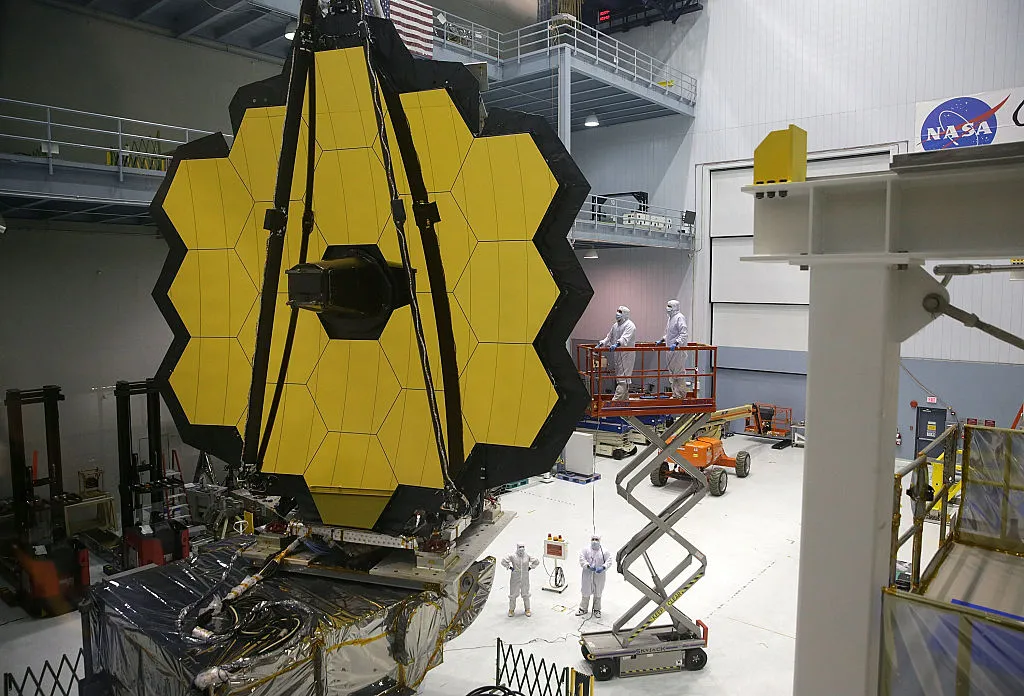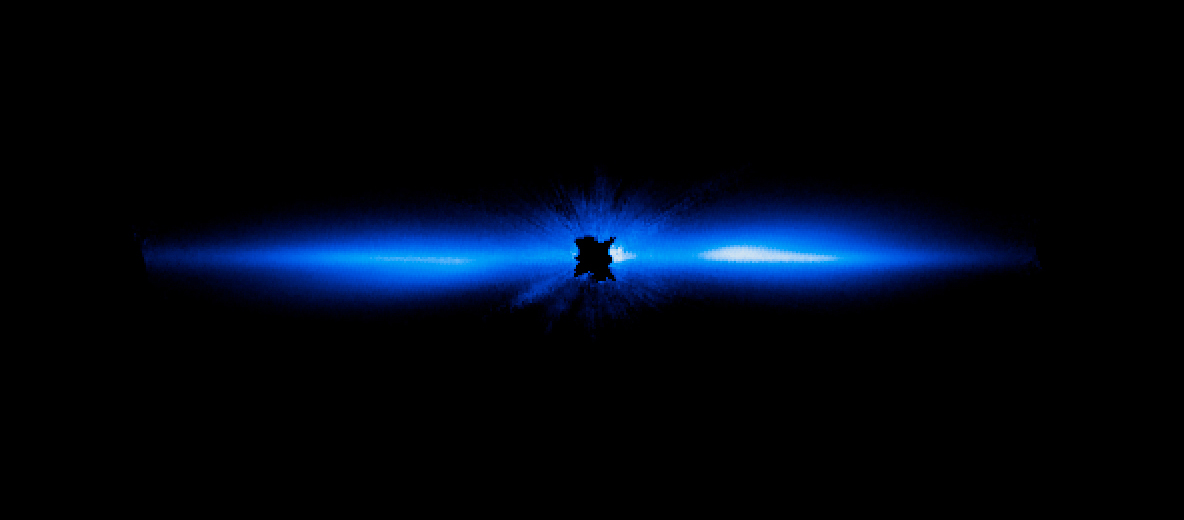Cosmic Tech
Why the launch of the James Webb telescope could be the most important event of our lifetime

After nearly $10-billion spent and almost two decades in the making, the James Webb Space Telescope was launched towards a destination well over a million kilometres from Earth, to look billions of years into the past, and study the true genesis of the galactic universe.
As of 24 January 2022, the approximately 6,200-kilogram James Webb Space Telescope had reached its destination, after a month-long 1.5 million kilometre journey from planet Earth to a location out in space, known as Sun-Earth Lagrange Point 2, or L2 for short. This point is in the opposite direction from the sun, such that our home planet is situated between the sun and the telescope; the telescope will always be on Earth’s night side as it follows an orbital path around the Sun. L2 is also an advantageous location because it is where the gravity from both the Sun and Earth balance in a way that keeps it in motion, ensuring that it tracks along with Earth’s orbit, and remains at the same general location relative to Earth.
Over the next five months, “Webb”, as the telescope is called by the US National Aeronautics and Space Administration (NASA), the agency leading the effort in partnership with the European Space Agency (ESA) and the Canadian Space Agency (CSA), will complete its commissioning period, during which it will be fully deployed, cooling itself down to operating temperatures, aligning its mirrors and calibrating its instruments.
With a five to ten-year mission ahead, NASA says that “Webb will fundamentally alter our understanding of the universe,” describing this moment as “a giant leap forward in our quest to understand humanity’s place in the great cosmic expanse”.

The Sunshield on NASA’s James Webb Space Telescope is the largest part of the observatory—five layers of thin membrane that must unfurl reliably in space to precise tolerances. Last week, for the first time, engineers stacked and unfurled a full-sized test unit of the Sunshield and it worked perfectly. Image: NASA/Chris Gunn

The James Webb Space Telescope is the scientific successor to NASA’s Hubble Space Telescope. It will be the most powerful space telescope ever built. Webb is an international project led by NASA with its partners, ESA (European Space Agency) and the Canadian Space Agency. Image: NASA/Desiree Stover

Engineers and technicians assemble the James Webb Space Telescope November 2, 2016 at NASA’s Goddard Space Flight Center in Greenbelt, Maryland. The telescope, designed to be a large space-based observatory optimized for infrared wavelengths, will be the successor to the Hubble Space Telescope and the Spitzer Space Telescope. It is scheduled to be launched in October 2018. (Photo by Alex Wong/Getty Images)

Engineers at NASA’s Goddard Space Flight Center use pressurized snow made from carbon dioxide to clean a test mirror for the James Webb Space Telescope. The crystals will knock particulates off the polished surface without scratching it. Image: NASA/Goddard/Chris Gunn
But what exactly will Webb do?
According to NASA, “Webb will peer back in time to when the universe was young — over 13.5 billion years ago, a few hundred million years after the big bang — to search the first galaxies in the universe.
“How did the universe begin? Are we alone in the cosmos?” Webb will help us answer scientifically significant questions about the early universe, the formation and evolution of galaxies, the birth of stars and protoplanetary systems, and the properties of planets within and outside our solar systems. Webb is the first observatory capable of observing the very earliest galaxies, and perhaps even some of the first exploding starts.”

NASA’s James Webb Space Telescope, the most ambitious and complex space observatory ever built, will use its unparalleled infrared capabilities to study Jupiter’s Great Red Spot, shedding new light on the enigmatic storm and building upon data returned from NASA’s Hubble Space Telescope and other observatories. This photo of Jupiter, taken by NASA’s Hubble Space Telescope, was snapped when the planet was comparatively close to Earth, at a distance of 415 million miles. Credits: NASA, ESA, and A. Simon (NASA Goddard)

A debris disk, which includes comets, asteroids, rocks of various sizes, and plenty of dust, orbits the star Beta Pictoris, which is blocked at the center of this 2012 image by a coronagraph aboard the Hubble Space Telescope. NASA’s James Webb Space Telescope will view Beta Pictoris in infrared light, both using its coronagraphs and capturing data known as spectra to allow researchers to learn significantly more about the gas and dust in the debris disk, which includes lots of smaller bodies like exocomets. Credits: NASA, ESA, and D. Apai and G. Schneider (University of Arizona)
Alongside these big questions, as well as potentially informing the answers to them, the mission’s science programme also allows for astronomers from around the world to apply for time and funding to use the telescope as an observatory for specific investigations. NASA says that for the first cycle, some 280 programmes submitted by 2,264 investigators from 41 countries have already been selected. There are also other programmes designed by members of the science and telescope teams, as well as what is called the “Director’s Discretionary Early Release Science”, a series of observations to be carried out in the first few months of the mission, which include “13 programmes with 253 investigators from 18 countries.”
All good and well, but how exactly will Webb look back billions of years back in time?
The secret to Webb’s time-travelling capabilities lies in the telescope’s gold-plated mirrors’ ability to detect light outside the narrow range of light visible to the human eye, specifically infrared light.
Webb is able to look at both near-infrared light and mid-infrared light. The former is closer to the visible range, has a shorter wavelength, and has the least amount of heat, that is to say not hot at all. An example would be the kind of infrared light emitted by your TV remote control. The latter on the other hand, while invisible to the human eye, has a longer wavelength, and emits a higher level of heat. Virtually all objects emit some degree of light from the visible to the invisible, and different kinds of light fall into a specific temperature range. The heat from the mid-infrared red light that we can’t see, for example, an infrared camera would be able to present visually depending on the different temperatures of different objects.
While light travels at the incredibly fast speed of 300,000 kilometres per second, such is the vastness of galactic distance that some light travels seconds to get to us, while some may take billions of years to reach Earth.
For example, the moon is about 368,000 kilometres from Earth, meaning that light from the moon takes 1.3 seconds to reach us. The Sun on the other hand is approximately 150 million kilometres from Earth, and as a result, its light takes 8.3 minutes to reach us. Effectively, whenever we are in the Sun, we’re experiencing light and warmth from 8.3 minutes ago. The brightest star in our night sky is called Sirius, and it is about 8.6 light-years away from Earth, which is to say that its light travels 8.6 years to reach us. So effectively, whenever we look at Sirius, we’re looking at 8.6 years into the past.
According to NASA, “Webb will study infrared light from celestial objects with much greater clarity and sensitivity than ever before. Unlike the short, tight wavelengths of visible light, longer wavelength of infrared light slip past dust more easily. Therefore, the universe of star and planet formation hidden behind clouds of dust comes into clear view for Webb’s infrared instruments.”

NASA engineer Ernie Wright looks on as the first six flight-ready primary mirror segments are prepped to begin final cryogenic testing at NASA’s Marshall Space Flight Center in 2011. This represents the first six of 18 segments that will form NASA’s James Webb Space Telescope’s primary mirror for space observations. Image: NASA/MSFC/David Higginbotham

This is a photo of one of the James Webb Space Telescope’s primary mirror segments coated with gold by Quantum Coating Incorporated. It’s NOT a flight segment, it’s the engineering design unit. The photo was taken at BATC by Drew Noel. Credit: Photo by Drew Noel
Effectively, Webb will be able to see light that has been travelling some 13 billion years, all the way to the formation of the first galaxies. It is designed to study the various stages and ages of galactic evolution, as well as give a clearer understanding of the “formation, evolution, and diversity of stars and planetary systems.”
Karl Glazebrook, director and professor for the Centre for Astrophysics & Supercomputing, at the Swinburne University of Technology, writes in an article published by The Conversation: “Closer to home, Webb will help us find molecules such as water, ammonia, carbon dioxide (and many others) within the solar system, the Milky Way and nearby galaxies. It will be able to see these in the atmospheres of planets around nearby stars, which is particularly exciting for the search for extraterrestrial life… For myself, perhaps the most exciting aspect to look forward to is the completely unknown. With Webb, we’ll be observing a previously murky cosmic era, when physical conditions were very different to those in the modern Universe. The history of astronomy suggests we can expect paradigm-shifting discoveries.”
Okay sure, but when can we expect the first galactic snaps?
As per NASA, Webb will begin gathering its first set of “scientific observations” after the commissioning process is complete, approximately towards the end of June 2022.
For those interested in keeping up with Webb’s journey and some of the early images, NASA recommends looking out for “Webb’s upcoming, stunning images on social media via @NASAWebb on Twitter, Instagram and Facebook, as well as the hashtag #UnfoldTheUniverse… News briefings and landing commentary are streamed on NASA TV, NASA.gov/live, and YouTube.com/NASA.” DM/ML

















 Become an Insider
Become an Insider
Totally can’t wait!
I wish they had chosen a more compelling name, rather than after some NASA bureaucrat. It reminds me of Jip de Jager Avenue and Mike Pienaar Boulevard much closer to (my) home. WTF were they!? By the by, also close to home, this year is the 201th annivesary of our own Obervatory “royal observatory”. From telling the time for the noon-day gun to SALT, just a journey here on its own.
SALT was just a point along the way. MeerKAT is here and the SKA is on the way! See https://www.skaobservatory.org/
I agree. There are many historical great names, as well as current Nobel-level astrophysicists that would be preferable.
In which direction do you look to “peer back in time”?
Is that light that has been travelling some 13 billion years not already past us?
Cosmic inflation after the big bang placed some stars so far away that their light is only now arriving. (Cosmologists are agreed, so just accept it.)
A 1: Any direction away from earth. A 2: The big bang is estimated at 13 billion years ago; what we see is post big bang; the 13 billion years can never pass us as we are part of it.